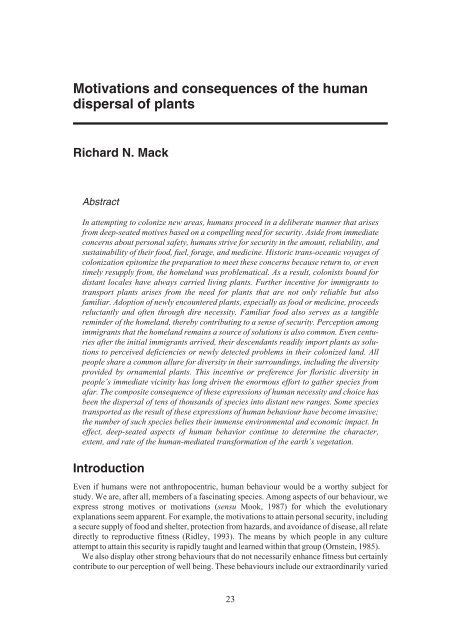Alien Species.vp - IUCN
Alien Species.vp - IUCN
Alien Species.vp - IUCN
Create successful ePaper yourself
Turn your PDF publications into a flip-book with our unique Google optimized e-Paper software.
Motivations and consequences of the human<br />
dispersal of plants<br />
Richard N. Mack<br />
Abstract<br />
In attempting to colonize new areas, humans proceed in a deliberate manner that arises<br />
from deep-seated motives based on a compelling need for security. Aside from immediate<br />
concerns about personal safety, humans strive for security in the amount, reliability, and<br />
sustainability of their food, fuel, forage, and medicine. Historic trans-oceanic voyages of<br />
colonization epitomize the preparation to meet these concerns because return to, or even<br />
timely resupply from, the homeland was problematical. As a result, colonists bound for<br />
distant locales have always carried living plants. Further incentive for immigrants to<br />
transport plants arises from the need for plants that are not only reliable but also<br />
familiar. Adoption of newly encountered plants, especially as food or medicine, proceeds<br />
reluctantly and often through dire necessity. Familiar food also serves as a tangible<br />
reminder of the homeland, thereby contributing to a sense of security. Perception among<br />
immigrants that the homeland remains a source of solutions is also common. Even centuries<br />
after the initial immigrants arrived, their descendants readily import plants as solutions<br />
to perceived deficiencies or newly detected problems in their colonized land. All<br />
people share a common allure for diversity in their surroundings, including the diversity<br />
provided by ornamental plants. This incentive or preference for floristic diversity in<br />
people’s immediate vicinity has long driven the enormous effort to gather species from<br />
afar. The composite consequence of these expressions of human necessity and choice has<br />
been the dispersal of tens of thousands of species into distant new ranges. Some species<br />
transported as the result of these expressions of human behaviour have become invasive;<br />
the number of such species belies their immense environmental and economic impact. In<br />
effect, deep-seated aspects of human behavior continue to determine the character,<br />
extent, and rate of the human-mediated transformation of the earth’s vegetation.<br />
Introduction<br />
Even if humans were not anthropocentric, human behaviour would be a worthy subject for<br />
study. We are, after all, members of a fascinating species. Among aspects of our behaviour, we<br />
express strong motives or motivations (sensu Mook, 1987) for which the evolutionary<br />
explanations seem apparent. For example, the motivations to attain personal security, including<br />
a secure supply of food and shelter, protection from hazards, and avoidance of disease, all relate<br />
directly to reproductive fitness (Ridley, 1993). The means by which people in any culture<br />
attempt to attain this security is rapidly taught and learned within that group (Ornstein, 1985).<br />
We also display other strong behaviours that do not necessarily enhance fitness but certainly<br />
contribute to our perception of well being. These behaviours include our extraordinarily varied<br />
23












